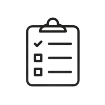Generally, treatment for migraine includes lifestyle changes, Acute treatment, or preventative treatment
Acute treatment such as over the counter painkillers, migraine specific treatments (triptans) and anti-sickness medication. These treatments aim to help manage the symptoms when an attack comes on. You do need to be careful not to take certain acute treatments too many days a month as this can cause medication overuse headache. For example, triptans shouldn’t be taken on more than 8-10 days per month.
Preventive treatment such as beta-blockers, tricyclic antidepressants or anti-epilepsy drugs. These treatments aim to reduce how often you have migraine attacks and how bad they are. You take them everyday and build them up to an effective dose. Some people need to try a range of treatments, or may be referred to a headache specialist if the treatments don’t work for them.
Lifestyle changes
Alongside the treatments many people benefit from reviewing whether lifestyle changes can help with their migraine attacks. This can include things like sticking to a routine, waking up at the same time each da, practicing good sleep hygiene, eating regularly and at similar times each day, not getting hungry and staying hydrated. Taking gentle exercise, such as walking and maintaining a healthy lifestyle can help. If there are factors such as alcohol or lack of sleep that seem to trigger your migraine attacks, there might be changes that you can make to help reduce how often you have attacks.
Over the counter medicines
Simple Painkillers, This is medication that treats the pain of a migraine attack at the time they are taken and includes paracetamol and non-steroidal anti-inflammatory drugs (NSAIDs) such as ibuprofen. It is medication that does not have opioids such a codeine in it. Painkillers that contain opioids are best avoided in migraine as benefits may be short-lived and they can be addictive.
Anti-sickness, This is medication that treats sickness (nausea and vomiting) that some people get with migraine attacks. They are also known as ‘anti-sickness’ medication.
During migraine attacks, gut absorption slows and medication absorption may be improved when taken with an anti-sickness medicine. Two anti-emetics, metoclopramide and domperidone, also help your body absorb the analgesics. Metoclopramide is associated with side effects (resulting in symptoms very like Parkinson’s disease, which is reversible) and should be avoided in children and young adults. Anti-emetics should be taken before or at the same time as any analgesics you are taking for the migraine attack.
Triptans, This is medication that was designed to treat migraine attacks. They reduce the pain and sickness of a migraine attack at the time they are taken.
Triptans are very safe when used appropriately by the people for whom they are prescribed. You should take them at the start of the head pain. If a triptan works, but the pain comes back you can usually take a second dose within 24 hours. As with all medication triptans can have side effects. Common side effects include nausea; jaw, neck or chest tightness, pressure or squeezing; rapid heart rate; fatigue; numbness or tingling (especially involving the face); or a burning sensation over the skin. If side effects are intolerable, or if their effects trouble you, you should always contact your doctor for review. People with coronary heart disease, cerebrovascular disease, peripheral vascular disease, uncontrolled hypertension, and acute vascular conditions should not take them.
Gepants, These are calcitonin gene-related peptide (CGRP) receptor antagonists. Compared to conventional acute treatments such as triptans, non-steroidal anti-inflammatory drugs (NSAIDs), and other painkillers, the gepants don’t seem to cause rebound or medication overuse headache. As such, they may be useful as a preventive treatment when taken regularly.
It is a new treatment and currently being reviewed for use on the NHS.
Combination treatments, It is possible to combine a triptan with a NSAID especially for people with longer lasting attacks or those in whom migraine attacks tend to recur. Several combination medicines are available. The most commonly used contain aspirin or paracetamol combined with codeine, caffeine and/or an antiemetic. Paracetamol is generally not effective for migraine attacks but may be combined in some treatments to improve the effectiveness e.g. Migraleve, Migramax. However, it is best to avoid codeine and opiates in migraine treatment as their benefits can be short term, with dependency and medication overuse headache risks being high.
You can buy a number of combination medicines for migraine without a prescription at your local pharmacy. If you’r enot sure which one I sbest for you, ask your pharmacist.
For more information about treatment, please refer to the NHS website here

TIPS
Get some useful tips to help prevent a migraine attack.

BUYING MIGRALEVE™
Find your nearest stockist of Migraleve products.

TRIGGER DIARY
Want to find out what triggers your migraines?


